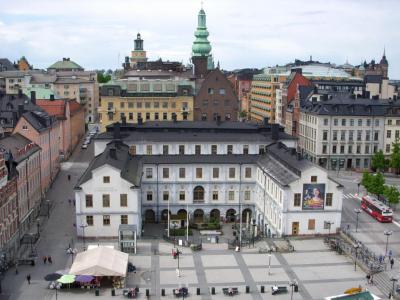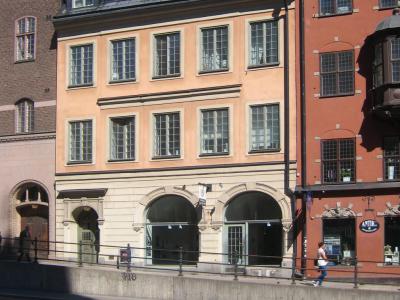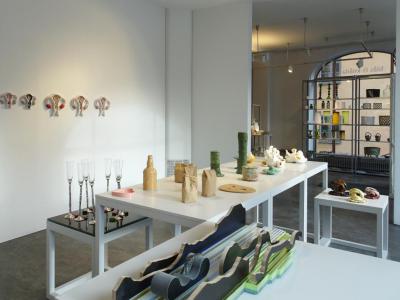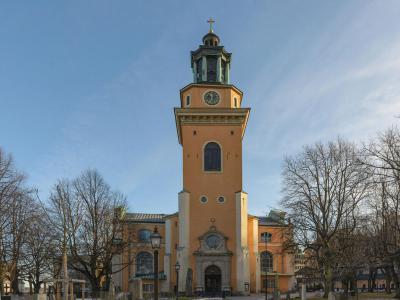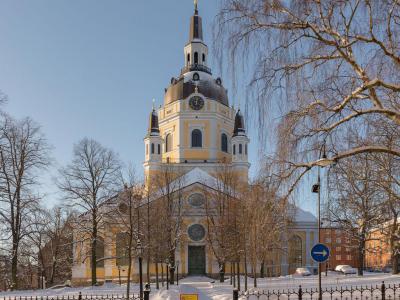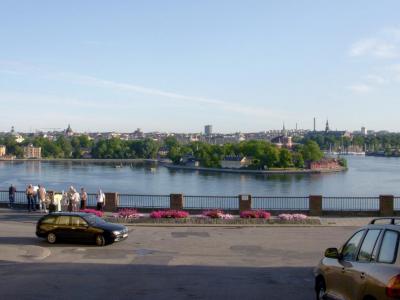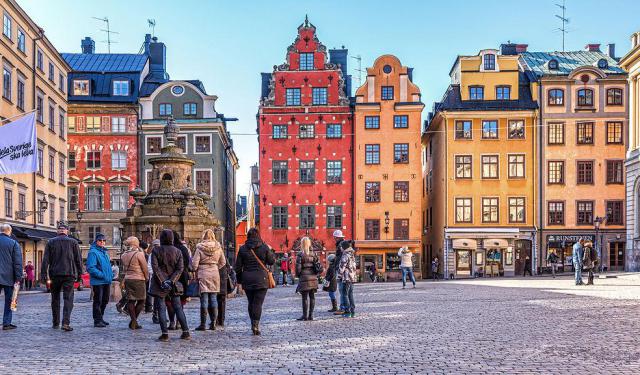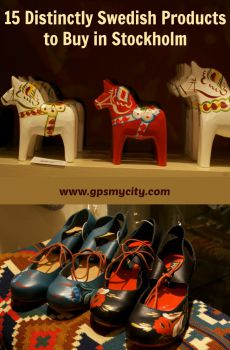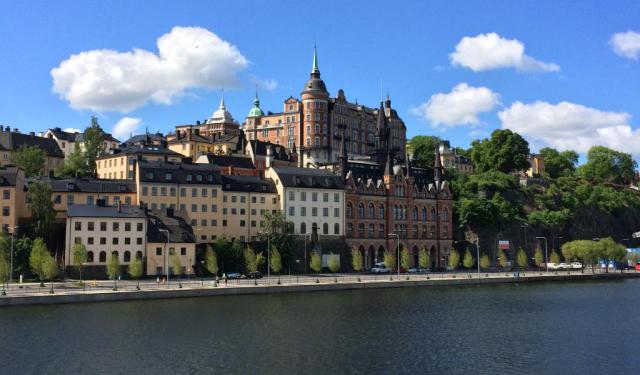
Sodermalm District Walking Tour (Self Guided), Stockholm
Södermalm, or "Söder" for short, is a borough in central Stockholm, incorporating a large island of the same name (formerly known as "Åsön"). Although considered an island, the water surrounding Södermalm to the north and south does not flow freely but passes through a series of locks. Visitors are charmed by the borough's narrow, cobbled streets and neat squares, as well as the cute little red cottages and some rather unique museums and galleries.
One notable institution in Södermalm is the Stockholm City Museum, which offers insights into the city's history and culture through various exhibits and collections. Art enthusiasts can explore the Swedish Printmakers Association and Galleri Blås & Knåda, both of which showcase the works of talented local artists.
Religious landmarks such as Maria Magdalena's and Catherine's churches add to the district's historical charm, offering visitors a glimpse into Sweden's religious heritage and architectural splendor.
For photography enthusiasts, the Swedish Museum of Photography (Fotografiska) provides a captivating journey through the art of visual storytelling. Its diverse exhibitions feature works by renowned photographers from around the world.
A visit to Södermalm would not be complete without experiencing the breathtaking views from Fjällgatan Terrace. Perched atop a hill, this vantage point offers panoramic vistas of Stockholm's skyline, making it an ideal spot for photography or simply soaking in the beauty of the city.
Stockholm's Södermalm district beckons visitors with its blend of history, art, and scenic wonders. There's something for everyone to discover in this dynamic neighborhood. If you want to appreciate Stockholm fully, don't miss the chance to immerse yourself in the cultural tapestry of Södermalm by taking this self-guided walk!
One notable institution in Södermalm is the Stockholm City Museum, which offers insights into the city's history and culture through various exhibits and collections. Art enthusiasts can explore the Swedish Printmakers Association and Galleri Blås & Knåda, both of which showcase the works of talented local artists.
Religious landmarks such as Maria Magdalena's and Catherine's churches add to the district's historical charm, offering visitors a glimpse into Sweden's religious heritage and architectural splendor.
For photography enthusiasts, the Swedish Museum of Photography (Fotografiska) provides a captivating journey through the art of visual storytelling. Its diverse exhibitions feature works by renowned photographers from around the world.
A visit to Södermalm would not be complete without experiencing the breathtaking views from Fjällgatan Terrace. Perched atop a hill, this vantage point offers panoramic vistas of Stockholm's skyline, making it an ideal spot for photography or simply soaking in the beauty of the city.
Stockholm's Södermalm district beckons visitors with its blend of history, art, and scenic wonders. There's something for everyone to discover in this dynamic neighborhood. If you want to appreciate Stockholm fully, don't miss the chance to immerse yourself in the cultural tapestry of Södermalm by taking this self-guided walk!
How it works: Download the app "GPSmyCity: Walks in 1K+ Cities" from Apple App Store or Google Play Store to your mobile phone or tablet. The app turns your mobile device into a personal tour guide and its built-in GPS navigation functions guide you from one tour stop to next. The app works offline, so no data plan is needed when traveling abroad.
Sodermalm District Walking Tour Map
Guide Name: Sodermalm District Walking Tour
Guide Location: Sweden » Stockholm (See other walking tours in Stockholm)
Guide Type: Self-guided Walking Tour (Sightseeing)
# of Attractions: 7
Tour Duration: 1 Hour(s)
Travel Distance: 2.3 Km or 1.4 Miles
Author: rose
Sight(s) Featured in This Guide:
Guide Location: Sweden » Stockholm (See other walking tours in Stockholm)
Guide Type: Self-guided Walking Tour (Sightseeing)
# of Attractions: 7
Tour Duration: 1 Hour(s)
Travel Distance: 2.3 Km or 1.4 Miles
Author: rose
Sight(s) Featured in This Guide:
- Stockholm City Museum
- Swedish Printmakers Association
- Galleri Blås & Knåda
- Maria Magdalena Kyrka (Maria Magdalena Church)
- Katarina Kyrka (Catherine's Church)
- Fotografiska (Swedish Museum of Photography)
- Fjällgatan Terrace
1) Stockholm City Museum
The Stockholm City Museum (Stadsmuseet i Stockholm), documenting, preserving and exhibiting the history of Stockholm, is housed in Södra Stadshuset at Slussen on Södermalm. Opened to the public in 1942, it is the largest municipal museum in Sweden, with the collection of 300,000 items of historical interest, 20,000 works of art, and 3 million photographs.
The museum has two permanent exhibitions, one called "The Stockholm Exhibition – Based on a true story". The first part of the Stockholm exhibition was opened in 2010. It tells the history of the Swedish capital from the first sign of settlements until the future ideas of children. It is all about buildings, streets, parks and water, as well as the inhabitants who fill the city with life. Here you can find a unique painting of Stockholm back in the 17th century. The second part of "The Stockholm Exhibition" was opened in April 2011. It focuses on the later part of the history of the city, taking you to four different locations, namely: Slussen, Östermalmstorg, Kungsträdgården and Sergels Torg, and telling their story.
The other permanent exhibition is "About houses – Architecture & building preservation in Stockholm". This exhibition guides visitors through various historical building styles, from the 1970s through the end of the last century, showcasing kitchen cabinets, wallpapers and door handles typical of the times and in many cases worthy of preservation.
The model of the planet Mercury on the yard of the museum is part of the Sweden Solar System – the largest model of the solar system in the world.
The museum also has a cafe and a shop, and in the summer, events, such as dance evenings, are held.
The museum has two permanent exhibitions, one called "The Stockholm Exhibition – Based on a true story". The first part of the Stockholm exhibition was opened in 2010. It tells the history of the Swedish capital from the first sign of settlements until the future ideas of children. It is all about buildings, streets, parks and water, as well as the inhabitants who fill the city with life. Here you can find a unique painting of Stockholm back in the 17th century. The second part of "The Stockholm Exhibition" was opened in April 2011. It focuses on the later part of the history of the city, taking you to four different locations, namely: Slussen, Östermalmstorg, Kungsträdgården and Sergels Torg, and telling their story.
The other permanent exhibition is "About houses – Architecture & building preservation in Stockholm". This exhibition guides visitors through various historical building styles, from the 1970s through the end of the last century, showcasing kitchen cabinets, wallpapers and door handles typical of the times and in many cases worthy of preservation.
The model of the planet Mercury on the yard of the museum is part of the Sweden Solar System – the largest model of the solar system in the world.
The museum also has a cafe and a shop, and in the summer, events, such as dance evenings, are held.
Sight description based on Wikipedia.
2) Swedish Printmakers Association
The Swedish Printmakers Association (Grafiska Sällskapet) brings under its umbrella almost 430 active printmakers from all over Sweden; their styles and techniques vary and encompass an array of means of expression. The association was founded in 1910 by a handful of artists with a firm intention, then as now, to further the interests of printmakers by arranging print exhibitions and distributing information about printmaking as an art form.
Pursuant to this agenda, today the association runs a gallery with a large collection of contemporary Swedish prints, which is regularly updated by its members. Each year, the new members are chosen by a jury carefully assessing the submitted works.
Right from the outset, the association has worked internationally, exhibiting in many countries, much as arranging foreign exhibitions at home. It functions as an information center and a meeting point for printmakers and those who like prints. The displayed works are available for sale and the staff are only keen to assist you with the choice.
Pursuant to this agenda, today the association runs a gallery with a large collection of contemporary Swedish prints, which is regularly updated by its members. Each year, the new members are chosen by a jury carefully assessing the submitted works.
Right from the outset, the association has worked internationally, exhibiting in many countries, much as arranging foreign exhibitions at home. It functions as an information center and a meeting point for printmakers and those who like prints. The displayed works are available for sale and the staff are only keen to assist you with the choice.
3) Galleri Blås & Knåda
Galleri Blås & Knåda is a professional body which boasts the largest in Sweden selection of contemporary workshop ceramics and studio glass, both utility and art objects. Started in May 1975 by 21 young glass and ceramic artists, the society has now expanded to 45 members, potters and glassblowers from all over Sweden, collectively running the shop and the gallery. The society enjoyed great success in the 1980s-1990s, which was then followed by a period of relative lull in demand for handmade art objects.
Today, the arts and crafts are back in fashion. Since the outset, Blås & Knåda has been a concept in arts and crafts circles. In 2008, they received the Villeroy & Boch Gustavsberg ceramics scholarship and today function as a center for glass and ceramics enthusiasts. All of the displayed items here are available for sale and have been made by the society members.
Today, the arts and crafts are back in fashion. Since the outset, Blås & Knåda has been a concept in arts and crafts circles. In 2008, they received the Villeroy & Boch Gustavsberg ceramics scholarship and today function as a center for glass and ceramics enthusiasts. All of the displayed items here are available for sale and have been made by the society members.
Sight description based on Wikipedia.
4) Maria Magdalena Kyrka (Maria Magdalena Church)
The Maria Magdalena Church (Maria Magdalena Kyrka) on Södermalm, Stockholm is steeped in history. It dates back to the 1350s when King Magnus Eriksson, with the permission of Pope Clement VI, built a funeral chapel on the site, dedicated to Mary Magdalene. A copperplate depicts that building as small, with a single nave adorned with a large tower and a pointy spire. What happened to it afterwards is poorly documented.
When Gustav Vasa liberated Stockholm in the early 1520s, his troops, led by Peder Fredag and encamped in the chapel, suffered severe losses at the hands of Christian II of Denmark attacking from the city. This prompted King Vasa to have all the churches, monasteries, and chapels on the ridges surrounding Stockholm, including that of Mary Magdalene, destroyed after the introduction of Protestantism in 1527. However, his son, King John III, started construction of a new church on this site in 1588. His death in 1592 halted the construction, and the church remained unfinished until 1634.
Inaugurated in 1676, the new church boasted Baroque appearance, courtesy of architects Nicodemus Tessin the Elder and the Younger. One of its top highlights is the painting of the high altar, the Adoration of the Shepherds at the Nativity, created by Louis Masreliez circa 1800. Another attraction is the Baroque pulpit, designed by Carl Johan Cronstedt and inaugurated in 1763, encrusted with an elegant medallion with the image of Mary Magdalene. The church also houses three organs: the oldest one, dating from 1774, designed by Carl Fredrik Adelcrantz; another 50-stop organ added in 1927; and a third, smaller organ added to the choir in 1986.
The fabulous baptismal font, made of rich copper with capital inscriptions, is one of the church's oldest effects. It dates back to 1638 and has successfully survived several fires and modifications. The church's spire, reportedly the most beautiful spire in Stockholm, wasn't so fortunate and perished in fire in 1759 together with some 300 buildings nearby. Superintendent Carl Johan Cronstedt was commissioned to rebuild the church and successfully did so in 1763, taking the utmost care to preserve its original design. The latter has been largely intact ever since; an interior restoration was made in 1927 and the exterior yellow color was ameliorated in 1986.
When Gustav Vasa liberated Stockholm in the early 1520s, his troops, led by Peder Fredag and encamped in the chapel, suffered severe losses at the hands of Christian II of Denmark attacking from the city. This prompted King Vasa to have all the churches, monasteries, and chapels on the ridges surrounding Stockholm, including that of Mary Magdalene, destroyed after the introduction of Protestantism in 1527. However, his son, King John III, started construction of a new church on this site in 1588. His death in 1592 halted the construction, and the church remained unfinished until 1634.
Inaugurated in 1676, the new church boasted Baroque appearance, courtesy of architects Nicodemus Tessin the Elder and the Younger. One of its top highlights is the painting of the high altar, the Adoration of the Shepherds at the Nativity, created by Louis Masreliez circa 1800. Another attraction is the Baroque pulpit, designed by Carl Johan Cronstedt and inaugurated in 1763, encrusted with an elegant medallion with the image of Mary Magdalene. The church also houses three organs: the oldest one, dating from 1774, designed by Carl Fredrik Adelcrantz; another 50-stop organ added in 1927; and a third, smaller organ added to the choir in 1986.
The fabulous baptismal font, made of rich copper with capital inscriptions, is one of the church's oldest effects. It dates back to 1638 and has successfully survived several fires and modifications. The church's spire, reportedly the most beautiful spire in Stockholm, wasn't so fortunate and perished in fire in 1759 together with some 300 buildings nearby. Superintendent Carl Johan Cronstedt was commissioned to rebuild the church and successfully did so in 1763, taking the utmost care to preserve its original design. The latter has been largely intact ever since; an interior restoration was made in 1927 and the exterior yellow color was ameliorated in 1986.
Sight description based on Wikipedia.
5) Katarina Kyrka (Catherine's Church)
Built on the site of the famous Stockholm Bloodbath, Katarina Kyrka (Catherine's Church) is one of the main and best known churches in the Swedish capital. It has a long history and took many years to build, from 1656 to 1695, being severely delayed by the shortage of funds of the then King Charles X of Sweden, under whose reign its construction had started. The church was named in honor of his mother, Princess Catherine.
The building reflects stylistic design of three architects including Jean de la Vallée, the original architect; Göran Josua Adelcrantz, the city architect, who designed a larger, octagonal tower and supervised the reconstruction of the church in 1723 following the first fire that ravaged it together with half of all the neighboring buildings in the parish; and Ove Hidemark, the architect who oversaw its reconstruction in 1990, when all but the exterior walls burned to the ground during the second fire, on May 17, 1990. The latter reconstruction took many painstaking years, with the utmost care taken to replicate the church's original 17th century appearance using the materials common for that period. The new organ was built by J. L. van den Heuvel Orgelbouw in the Netherlands.
Among the prominent Swedes buried in the church graveyard are the Swedish statesman and regent of Sweden in 1470–1497 and 1501–1503 Sten Sture the Elder, football player Sven Bergqvist, popular Dutch-Swedish singer Cornelis Vreeswijk, and the assassinated in 2003 Swedish Foreign Minister Anna Lindh.
Karl XII's Stair is the double staircase that leads from the cemetery up to the southern entrance of the church, and was built sometime between 1712 and 1715. It was named after Karl (Charles) XII of Sweden, who was the king at the time, and was dedicated in 1715, as indicated by the date on the portion on the stair's landing. The railing was made by the blacksmith, Benjamin Roth, and renovated by his son, Carl Roth, in 1776. On the pillars on either side of the stair is engraved a poem about Karl XII.
The building reflects stylistic design of three architects including Jean de la Vallée, the original architect; Göran Josua Adelcrantz, the city architect, who designed a larger, octagonal tower and supervised the reconstruction of the church in 1723 following the first fire that ravaged it together with half of all the neighboring buildings in the parish; and Ove Hidemark, the architect who oversaw its reconstruction in 1990, when all but the exterior walls burned to the ground during the second fire, on May 17, 1990. The latter reconstruction took many painstaking years, with the utmost care taken to replicate the church's original 17th century appearance using the materials common for that period. The new organ was built by J. L. van den Heuvel Orgelbouw in the Netherlands.
Among the prominent Swedes buried in the church graveyard are the Swedish statesman and regent of Sweden in 1470–1497 and 1501–1503 Sten Sture the Elder, football player Sven Bergqvist, popular Dutch-Swedish singer Cornelis Vreeswijk, and the assassinated in 2003 Swedish Foreign Minister Anna Lindh.
Karl XII's Stair is the double staircase that leads from the cemetery up to the southern entrance of the church, and was built sometime between 1712 and 1715. It was named after Karl (Charles) XII of Sweden, who was the king at the time, and was dedicated in 1715, as indicated by the date on the portion on the stair's landing. The railing was made by the blacksmith, Benjamin Roth, and renovated by his son, Carl Roth, in 1776. On the pillars on either side of the stair is engraved a poem about Karl XII.
Sight description based on Wikipedia.
6) Fotografiska (Swedish Museum of Photography) (must see)
Fotografiska (The Swedish Museum of Photography) is one of the world's largest and most important photography museums, and is a truly international melting pot for contemporary photography graced by the likes of Martin Schoeller, Robert Mapplethorpe, Nick Brandt, Annie Leibovitz, David Drebin and other key power players. The centre opened on 21 May 2010 in a historical industrial Art Nouveau building of the former Royal Customs Office at Stadgårdskai. Designed by Ferdinand Boberg, the 1906 building is listed as of cultural interest. The original brick facade is intact, whereas the interiors had to be renovated to house the center.
Fotografiska encompasses 2500 m2 of exhibition space spread over two floors, an academy, bistro, cafe, bar, conference rooms, book and souvenir shop, photo gallery, and event spaces, and receives annually over 500,000 visitors, which makes it one of Stockholm's key tourist attractions. Aldo adding to its appeal is the unbeatable panorama of Djurgården island and water views opening from the top floor cafe.
Four major main exhibitions and about 20–25 smaller ones, featuring various national and international photo artists, are held here annually. In addition to photography exhibitions, Fotografiska also offers courses, lectures and workshops for amateur and professional photographers, as well as concerts and 'artist talks'.
The Fotografiska restaurant is praised for its sustainable gastronomy, focused on green seasonal, local and organic produce. Both lunch and dinner are served, and during an extensive weekend, brunch menu is also available. The on-site bar is also heavily influenced by Fotografiska's dedication to sustainable practices. Organic, non-alcoholic beverages are served here with liquor on the side. As for the cafe, it offers organic, well-made soups, pastries and home-roasted coffee. In the evening the cafe is transformed into a bar.
Tip:
The photography museum is barrier-free and accessible by wheelchairs and baby carriages. There are ramps at the entrances and lifts in the two stairwells, plus disabled toilets and changing tables on the ground floor and in the cafe on the second floor.
Dogs are not allowed in the building.
All payments at Fotografiska are made by card – no cash payments possible.
Fotografiska encompasses 2500 m2 of exhibition space spread over two floors, an academy, bistro, cafe, bar, conference rooms, book and souvenir shop, photo gallery, and event spaces, and receives annually over 500,000 visitors, which makes it one of Stockholm's key tourist attractions. Aldo adding to its appeal is the unbeatable panorama of Djurgården island and water views opening from the top floor cafe.
Four major main exhibitions and about 20–25 smaller ones, featuring various national and international photo artists, are held here annually. In addition to photography exhibitions, Fotografiska also offers courses, lectures and workshops for amateur and professional photographers, as well as concerts and 'artist talks'.
The Fotografiska restaurant is praised for its sustainable gastronomy, focused on green seasonal, local and organic produce. Both lunch and dinner are served, and during an extensive weekend, brunch menu is also available. The on-site bar is also heavily influenced by Fotografiska's dedication to sustainable practices. Organic, non-alcoholic beverages are served here with liquor on the side. As for the cafe, it offers organic, well-made soups, pastries and home-roasted coffee. In the evening the cafe is transformed into a bar.
Tip:
The photography museum is barrier-free and accessible by wheelchairs and baby carriages. There are ramps at the entrances and lifts in the two stairwells, plus disabled toilets and changing tables on the ground floor and in the cafe on the second floor.
Dogs are not allowed in the building.
All payments at Fotografiska are made by card – no cash payments possible.
Sight description based on Wikipedia.
7) Fjällgatan Terrace
Much loved by Stockholmers, Fjällgatan street stretches along Stigberget hill, between Renstiernas gata in the west and Erstagatan in the east on Södermalm, and is affectionately referred to by locals as their “balcony”. Situated 27.8 meters above Saltsjön bay, it offers vantage point for an unobstructed view over Stockholm's inlet, Gamla Stan, the museum island of Skeppsholmen, and the island of Djurgården, the most visited tourist destination in Stockholm. Back in 1913, politician Anna Lindhagen campaigned for the area south of Fjällgatan to become a cultural reserve to be saved for posterity. However, the decision came only in 1956, long after her death.
In 1885, Fjällgatan got its current name as part of Stockholm's major street name revision that year. Prior to that, it was called “Katarina östra kyrkogata” and was then a long continuous stretch of street together with the current Mäster Mikaels gata. The preceding name for it was Gallgebergets gatan, and it came from Södermalm's gallows which stood on Stigberget and was Stockholm's execution site for most of the 16th and 17th centuries.
At the northwestern end of the viewing platform is a cafe with a sun room. Here you can enjoy the view even if the weather is windy or rainy. Along both sides of Fjällgatan there are several blocks with well-preserved wooden houses, some dating back as far as the 1700s, blue-marked as objects of cultural-historical value by the City Museum in Stockholm.
At Fjällgatan 37, where the summer cafe Fjällgatans Kafféstuga is located, is a former dormitory built in 1872 on the initiative of the cereal wholesaler CH Matton following drawings by architect Axel Kumlien. Matton's cereal warehouse was demolished when Stadsgården was redeveloped around the turn of the 1900s. A fraction of it is now part of Fjällgatan coffee house.
At Fjällgatan 34 there is a small living museum, Stigbergets borgarrum, created by Anna Lindhagen, showcasing a bourgeois family household during the mid 19th century. For the last few years of her life, Lindhagen herself had occupied two rooms here. The memorial sculpture of Anna Lindhagen has been installed outside the house since 1987.
In 1885, Fjällgatan got its current name as part of Stockholm's major street name revision that year. Prior to that, it was called “Katarina östra kyrkogata” and was then a long continuous stretch of street together with the current Mäster Mikaels gata. The preceding name for it was Gallgebergets gatan, and it came from Södermalm's gallows which stood on Stigberget and was Stockholm's execution site for most of the 16th and 17th centuries.
At the northwestern end of the viewing platform is a cafe with a sun room. Here you can enjoy the view even if the weather is windy or rainy. Along both sides of Fjällgatan there are several blocks with well-preserved wooden houses, some dating back as far as the 1700s, blue-marked as objects of cultural-historical value by the City Museum in Stockholm.
At Fjällgatan 37, where the summer cafe Fjällgatans Kafféstuga is located, is a former dormitory built in 1872 on the initiative of the cereal wholesaler CH Matton following drawings by architect Axel Kumlien. Matton's cereal warehouse was demolished when Stadsgården was redeveloped around the turn of the 1900s. A fraction of it is now part of Fjällgatan coffee house.
At Fjällgatan 34 there is a small living museum, Stigbergets borgarrum, created by Anna Lindhagen, showcasing a bourgeois family household during the mid 19th century. For the last few years of her life, Lindhagen herself had occupied two rooms here. The memorial sculpture of Anna Lindhagen has been installed outside the house since 1987.
Sight description based on Wikipedia.
Walking Tours in Stockholm, Sweden
Create Your Own Walk in Stockholm
Creating your own self-guided walk in Stockholm is easy and fun. Choose the city attractions that you want to see and a walk route map will be created just for you. You can even set your hotel as the start point of the walk.
Old Town (Gamla Stan) Walk
The Gamla stan (Old Town) of Stockholm is the oldest part of the city, established in the 13th century. Officially known, prior to 1980, as “The Town Between Bridges” (Staden mellan broarna), this bustling, yet compact area abounds in medieval alleyways, cobbled streets, and archaic (17th- and 18th-century) colorful architecture, showing a great deal of North Germanic influence.
There are... view more
Tour Duration: 2 Hour(s)
Travel Distance: 2.6 Km or 1.6 Miles
There are... view more
Tour Duration: 2 Hour(s)
Travel Distance: 2.6 Km or 1.6 Miles
City Center (Norrmalm) Walk
Once an independent town, Norrmalm has been integral to Stockholm since 1635. As one of the city's central neighborhoods, it saw many old buildings torn down during the 1950s and 60s to clear space for new construction. Still, the most notable pieces of local architecture – featuring a wide range of styles, from Late Gothic to Renaissance and Baroque – are still in place and make Norrmalm... view more
Tour Duration: 2 Hour(s)
Travel Distance: 3.0 Km or 1.9 Miles
Tour Duration: 2 Hour(s)
Travel Distance: 3.0 Km or 1.9 Miles
The Museums Island Walk
With almost 70 museums in operation, Stockholm is one of the richest (in terms of museums) cities on the planet. The island of Djurgården, a cultural hotspot inside the capital, also known as the Museums Island, is home to an array of museums and other cultural attractions suitable for visitors of all ages.
One of the most renowned venues on the island is Scandinavia’s most popular museum,... view more
Tour Duration: 2 Hour(s)
Travel Distance: 3.3 Km or 2.1 Miles
One of the most renowned venues on the island is Scandinavia’s most popular museum,... view more
Tour Duration: 2 Hour(s)
Travel Distance: 3.3 Km or 2.1 Miles
Useful Travel Guides for Planning Your Trip
Souvenir Shopping Guide: 15 Distinctly Swedish Products to Buy in Stockholm
If you come to Stockholm on the trail of Karlsson-on-the-Roof character (Swedish: Karlsson på taket), created by Astrid Lindgren, you're bound to enjoy yourself big time! Just don't forget to spare some time for gift shopping, so as to please your loved ones back home. In doing so, you...
The Most Popular Cities
/ view all
